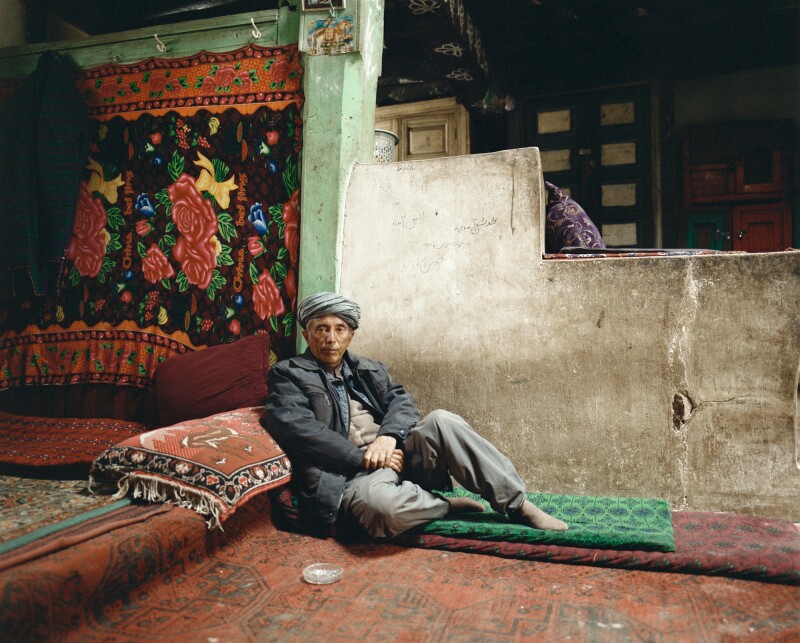You get older faster in the Wakhan Corridor. The harshness of life—the wind, the constant work of farming and herding, the below-freezing temperatures 340 days out of the year—is etched onto the faces of the native Wakhi and the nomadic Kyrgyz, the Muslim peoples who have lived for generations in this remote pocket of land jutting out of northeastern Afghanistan. Deep in some of Central Asia’s highest mountain ranges, the narrow 200 miles of the Wakhan Corridor are bordered by Tajikistan, China, and Pakistan, as well as mainland Afghanistan, which is so far removed from daily life in the Wakhan that it is often referred to as a foreign country. In the local dialect, the region is called Bam-e Dunya, the roof of the world. And from the moment French photographer Frédéric Lagrange heard of the place, all he could think of was how to reach it.

“I found the Wakhi to be the most hospitable people,” Lagrange says. “They have nothing, but they give everything.”
Photo by Frédéric Lagrange
It all began with A Short Walk in the Hindu Kush, the 1958 account of a trek through northeastern Afghanistan written by a mild-mannered-Londoner-turned-adventurer named Eric Newby. When Lagrange read the book more than a decade ago, he was immediately captivated by Newby’s descriptions. But it would take Lagrange years to carve out a month to trek the Wakhan Corridor with four Wakhi porters, an Afghan guide, several donkeys, and 100 rolls of film. In the late winter of 2012, the group set out.

A veiled Sunni woman made her way back to mainland Afghanistan from the desert of the Wakhan Corridor.
Photo by Frédéric Lagrange
Since Marco Polo’s voyage into the Wakhan Corridor in the late 1200s, few Westerners have made the trip along this part of the old Silk Road. Lagrange was the first in six months to cross the Tajik border into Afghanistan. The land is “a last frontier,” he says. “That’s why it became an obsession. I had to go there to witness it, to feel what it is. I had no expectations. I wanted to get it out of my system. And I wanted to come back alive.”

Kyrgyz women wear ornate costumes with headdresses. “Considering how they live, I found it impressive to have so much pageantry.”
Photo by Frédéric Lagrange
The Wakhan’s beauty is rivaled only by its extreme inaccessibility. “The advancements of modernity come at a very slow pace,” says Lagrange. Doctors and schools are scarce. Homes are yurts or mud huts. There is no cell phone service, no television, no Internet. Such isolation means that the Wakhi and Kyrgyz live much as they have for hundreds of years, but the trade-offs, Lagrange learned from local Wakhan leaders, can be grave: high infant mortality rates; opium addiction; a staggering number of women who die in childbirth. Sometimes there is barely enough food to make it through the long winters.
“There’s nothing that protects you in the Wakhan,” says Lagrange. “There’s a fragility you feel because the elements get to you directly. It’s an incredibly challenging place.”

After a day of shyly avoiding him, this young girl finally let Lagrange get close enough to take her photo.
Photo by Frédéric Lagrange
But everyday life in the Wakhan proved to be Lagrange’s inspiration. He usually trekked 15 miles a day, he says, “interacting with the people around me as much as possible, but also trying to step back to be able to observe and catch elements of life without disrupting them.” Lagrange shot photographs and footage that became a 20-minute film, Lost on the Roof of the World. “I was purely living in the moment,” he says, “observing and recording as much as possible.”

“I could see the Wakhis’ love of their surroundings,” Lagrange says. “They always took the time to slow down and observe.”
Photo by Frédéric Lagrange
Lagrange waited until he was back home in New York three months later to develop the film. “I rarely think of my work this way, but I was really touched by it,” he says. “It was deeply moving to be there as a human being, but the imagery, professionally, was beyond my wildest expectations. There’s a certain legacy there—of giving a voice, a face, and dignity to those people. And to Afghanistan.”
Frédéric Lagrange shot the stunning short film, “Lost on the Roof of the World”, during his trip to the Wakhan Corridor region of Afghanistan. Watch a clip below.











